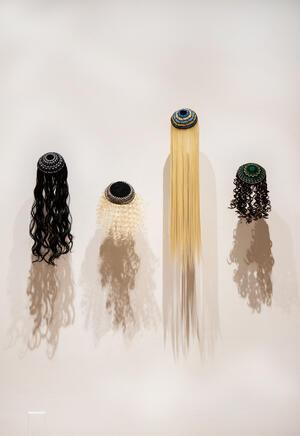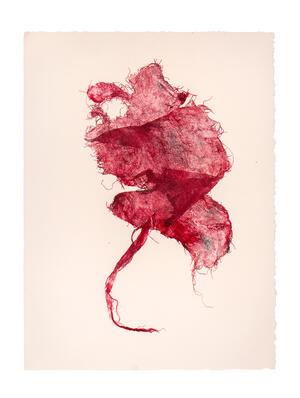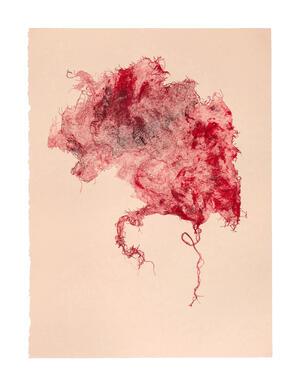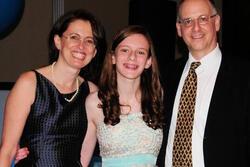7 Questions For Artist Gavi Weitzman
JWA talks to Gavi Weitzman, a multimedia artist based in Philadelphia whose work explores Judaism, the body, and identity.
JWA: When did you become interested in Judaism and feminism?
Gavi Weitzman: Growing up as a woman alongside a twin brother in mainstream Modern Orthodox spaces, I noticed from a young age that there were different expectations for us in Jewish ritual. When you’re a kid, you hold a strong sense of fairness. Why does he get to do this, sit here, wear this, and I don’t? As I got older, this question lingered, and eventually I was able to work through my feelings about gender and Judaism through my art.
While in school, I lived with a group of Jewish girls with a variety of religious backgrounds. We’d stay up late comparing experiences, reflecting on our Jewish backgrounds and analyzing the gender dynamics we saw in the Jewish spaces we grew up in. I was surrounded by other Jewish women who wanted to engage with ritual, yet struggled to fit into a male-dominated tradition. This was very powerful and affirming in my own feminist religious journey.
JWA: Why did you choose to explore these themes in your art?
GW: Inspired by these conversations with my roommates, I started to explore my personal experience of gendered Jewish practices—not only to explain how it felt to be on the other side of the mechitzah, but also to reimagine these rituals in a modern context. At the time, I was reading a lot of feminist literature and learning about feminist artists in the 1960s and 70s, such as Carolee Schneeman, who used their bodies, their voices, and [their] experiences to combat the historically male-dominated art world. I identified with their ethos, the impulse to expose the dark underbelly of a longstanding power structure and the people who perpetuate it.
But unlike the feminist artists who often called for the destruction of the system entirely, I had a love for the system that I inherited. I could not throw it away and instead wanted to take the language of Jewish practice and reimagine it. Through exploring these themes in my work, I allowed myself to engage with Judaism in a completely new way that was entirely my own.
JWA: How has your art evolved over your years of creating, first as a student artist and now as a professional artist?
GW: In school, a lot of my work focused on reimagining male-associated Jewish practices such as tzitzit, kippot, and Torah study through object-making and printmaking. These pieces were playful expressions of my frustrations with the lack of women’s voices I saw in the rituals and my impulse to change the way we think about women in observant spaces. As I’ve transitioned to life as a professional artist, I’ve become more interested in ketubot and women's associated practices like niddah and the laws associated with marital purity. These practices are private and intimate, done behind closed doors in the privacy of the home. Instead of trying to create change, I want to use this art to reveal the authentic beauty and grittiness of these rituals. My intention is to teach the public about these practices and to bring women together in awe of our own power and experiences.
JWA: Your pieces such as Kippot and Hair Paths portray hair as it relates to gender and Jewish ritual. What made you choose this motif, and what do you hope to explore with it?
GW: I love hair on so many levels—formally, philosophically, and specifically how it relates Jewishly to our connection with God. First, hair is a symbol of identity and personal history. It is genetic—my mom and I have curly hair, and taking care of our hair is something that we bond over. Second, I love the line quality of hair, how it is made of many individual strands that together create a large mass. I also love that it is ever-changing. There will never be another moment where all the strands exist in the same position. I am also fascinated with hair as an abject body—that when it is on your head it is beautiful, but when decontextualized from the body it becomes disgusting.
Going back to feminism and gender in Judaism, I am also interested in the gender-specific Jewish customs that have to do with hair and hair-covering. Traditionally, women cover their hair when they get married, and men wear kippot to remind them of their connection to God. I’m interested in how these customs have an impact on a person’s identity—how does a kippah tell the world who you are and what you believe? What happens when you must cover something that is a big part of yourself and your image? There are many levels to my specific interest in hair, both as a concept and as an art medium.
JWA: Your work explores intimate experiences of Jewish women, such as the Bedikot series. These prints portray blood stains inspired by the practice of bedikah, a self-performed internal examination of the vaginal canal to check for menstruation as part of the observance of the laws of niddah. What conversations are you hoping to spark by depicting these topics that are often regarded as private or even taboo?
GW: My intention for these pieces is to reveal what is hidden. I see Bedikot as a series of portraits—demonstrations of monstrous beauty. Each image is a monoprint, meaning that it is irreplicable and irreplaceable. I wanted to use these images as ways to explore the power of the female body and its ability to repel, repulse, expel, disgust, discharge, and create life. It is up to the viewer about how the work makes them feel. What do they see in it? It encourages them to look inward, to ask why might they be repulsed. Why does it produce a visceral response? That reaction is as much a part of the work as the image itself.
JWA: For Tzitzim, you crocheted a bra and panty set in the style of a yarmulke and tzitzit, in the color white for Yom Kippur. What was your inspiration for this artwork, and have audience responses been what you expected?
GW: Whenever I tell people about Tzitzim, they get very excited. The piece really started as a joke, but slowly became something much more. It is inspired by a line in the third paragraph in [the] Shema which reads, “This shall be your tassels, and you shall see it and remember all of the Lord’s commandments and keep them, not straying after your heart and after your eyes, following your lustful desires.” I remember reading this in the English translation for the first time and thinking about how many times in the past I had said this phrase, yet in that moment I felt so clearly that this prayer was not meant for me; I had never worn tzizit. So I created my own pair of women’s four-cornered undergarments with halachically-tied tzitzit that poked at this idea that tzitzit are meant to guide against lustful desires. I then wore them beneath my clothes on Yom Kippur, a secret between me and God. Tzitzim is a radical reimagining of a Jewish obligation—tying fringes on the four corners of your garments—adapted to modern femininity. I ask, what would a woman’s four-cornered garment look like? And maybe, if you look at it that way, it isn’t so radical after all.
JWA: Your photography installation שלא עשני אשה (For Not Making Me a Woman) responds to the prayer that Orthodox Jewish men recite everyday thanking God for not making them women. You question how the “repetitive magnitude” of this prayer has “shaped the Jewish subconscious.” How can art help us grapple with the aspects of Judaism we may struggle with as feminists?
GW: With this piece, I wanted to visualize how many times this phrase has been said and how it begins to permeate the environment beyond the prayer space. The abundance of images is meant to be overwhelming, as is the idea that these phrases have been said over and over again. Without visualizing it, the true impact of these words is invisible, only felt by those that are hurt by them. I believe that it is important to not shy away from difficult topics and conversations because they might be controversial. We must engage with uncomfortable ideas in order to move forward. Sitting on the walls of my apartment, my work serves as a personal reminder of my own struggles with aspects of Judaism, but also as a reminder of my love for the tradition, its flaws, and its ability to change and grow.














